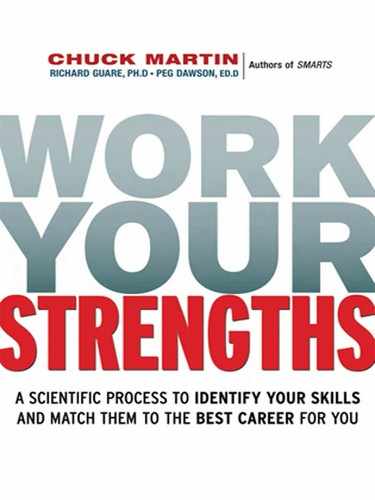0%
25Chapters
0-1Hours read
0kTotal Words
Book Description
Ever feel like you’re in the wrong job, maybe even the wrong career? You may be right. But before you make another move, consider this: Your brain is hardwired with a unique combination of 12 different Executive Skills—the cognitive strengths that determine how well you will perform in a particular role. Your strongest and weakest Executive Skills can make the difference between big-time career success and years of disappointment and failure. Work Your Strengths helps you avoid “trial-and-error” career moves by matching your strengths to the jobs that call on those skills specifically. Based on the authors’ two-year study of more than 2000 top-performers at hundreds of organizations of all types, from Fortune 500 companies to nonprofits, the book reveals which strengths correlate with success in different jobs. Take a one-time, free online profile to determine your unique strengths and weaknesses and then use that information to identify your ideal career path. Not ready for a move yet? Work Your Strengths can also make a world of difference in the job you’re in now. It can help you not only focus on the projects best suited for you but also recognize skills in others and assign tasks accordingly. So whether you’re planning a jump to the career of your dreams or just wondering how to make your current job easier and more rewarding, Work Your Strengths gives you the science and the system to find your success.Table of Contents
- Cover Page
- Title Page
- Copyright Page
- Dedication
- Contents
- Acknowledgments
- Introduction
- Chapter 1: Determining Your Own Strengths and Weaknesses ... and Finding the Strengths and Weaknesses of Others
- Skill 1: Response Inhibition
- Skill 2: Working Memory
- Skill 3: Emotional Control
- Skill 4: Sustained Attention
- Skill 5: Task Initiation
- Skill 6: Planning/Prioritization
- Skill 7: Organization
- Skill 8: Time Management
- Skill 9: Goal-Directed Persistence
- Skill 10: Flexibility
- Skill 11: Metacognition
- Skill 12: Stress Tolerance
- Finding Your Own Strengths and Weaknesses
- Workload and Executive Skills
- Voices from the Front Lines: Workload
- Exceeding Your Cognitive Bandwidth
- Knowing in Advance
- Chapter 2: Finding Success and Avoiding Failure: Why Your Strengths and Weaknesses Are the Way They Are: The Science Behind Executive Skills
- Chapter 3: What Is a High Performer and How Do You Become One? Selecting the Right Path to Increase the Chance of Success
- Performance-Based: Consistency Is Key
- Quantitative: Expectations and Results
- Qualitative: Some Subjectivity
- Position in the Organization
- Company First
- Multidimensional
- How Many Are High Performers?
- Voices from the Front Lines: Number of High Performers
- What Sets High Performers Apart
- Voices from the Front Lines: What Sets Them Apart
- Chapter 4: Navigating Your Road to High Performance: Finding Your Skills Combination to Determine What Industry You Should Be In
- Most Prevalent Executive Skills Strengths and Weaknesses
- Some Skills Go Hand in Hand
- Strengths vs. Commonly Found Weaknesses
- High-Performing Males vs. High-Performing Females
- Executive Skills of High Performers by Age
- Task Initiation: The Common Weakness
- The High-Performing Pair
- Executive Skills of High Performers by Industry
- Financial Services
- Healthcare
- Manufacturing
- Technology
- Education
- Nonprofits
- Finding the Match
- Chapter 5: What’S the Right Department for You? The Strengths of High Performers by Department
- Marketing/Advertising/Promotion: Always Getting Better
- Sales: Not Falling Through the Cracks
- Systems/IT: All About Road Maps
- General Management: Goal-Oriented
- Operations: Good on the Fly
- Customer Service: Strategically Important
- Administrative: Organized and Can Adapt
- Finance: Modify on the Fly
- Accounting: Methodical Approach
- Clinical: Organized and Starting Right Away
- Executive Skills in a Department: Clinical High Performers
- Right-Seating People the First Time
- Chapter 6: Do You Have What It Takes to Be in the Corner Suite? Skills Broken Down by Title
- Chapter 7: How Your Strengths Match Those Of Others at Work: Ways to Match Behaviors to Executive Skills in Your Business
- Shared Strengths in One Organization
- Shared Strengths in Two Nonprofits
- Mapping Characteristics to Executive Skills
- Avoiding Potential Conflicts
- Focus on Executive Skills Strengths
- Voices from the Front Lines: Strengths and Weaknesses
- Healthcare: Clinical vs. Nonclinical
- High Performers in Sales-Buyer Interactions
- Observable Behaviors
- Strong Flexibility: Typical Behaviors
- Weak Flexibility: Typical Behaviors
- Strong Response Inhibition: Typical Behaviors
- Weak Response Inhibition: Typical Behaviors
- Chapter 8: Avoiding the Wrong Promotion: Sorting the Strengths Of Employees Vs. Managers Vs. Executives
- Voices from the Front Lines: High and Low Performers
- The Failed Sales Promotion
- Voices from the Front Lines: Promoting Salespeople to Management
- Sales Employees vs. Sales Management
- Working in a Comfort Zone
- Voices from the Front Lines: Job Satisfaction
- IT Executives Can Shield the Heat
- Operations: Order and Organization
- Administrative: Organization Is Key
- Customer Service: Recalling Past Solutions
- Can Performance Be Predicted?
- Chapter 9: Determine Your Fit—the High-Performance Executive Skills Map: Where Do High Performers With Your Strengths Work?
- Response Inhibition
- Working Memory
- Emotional Control
- Sustained Attention
- Task Initiation
- Planning/Prioritization
- Organization
- Time Management
- Goal-Directed Persistence
- Flexibility
- Metacognition
- Stress Tolerance
- The High-Performance Executive Skills Map
- Industries by Executive Skills Strengths
- Departments by Executive Skills Strengths
- Job Functions/Titles by Executive Skills Strengths
- Conclusion
- Appendix A: How the Two-Year Study Was Conducted: High Performers and the Executive Skills Profile
- Appendix B: The High-Performance Executive Skills Tables
- Appendix C: About NFI Research
- Notes
- Index
